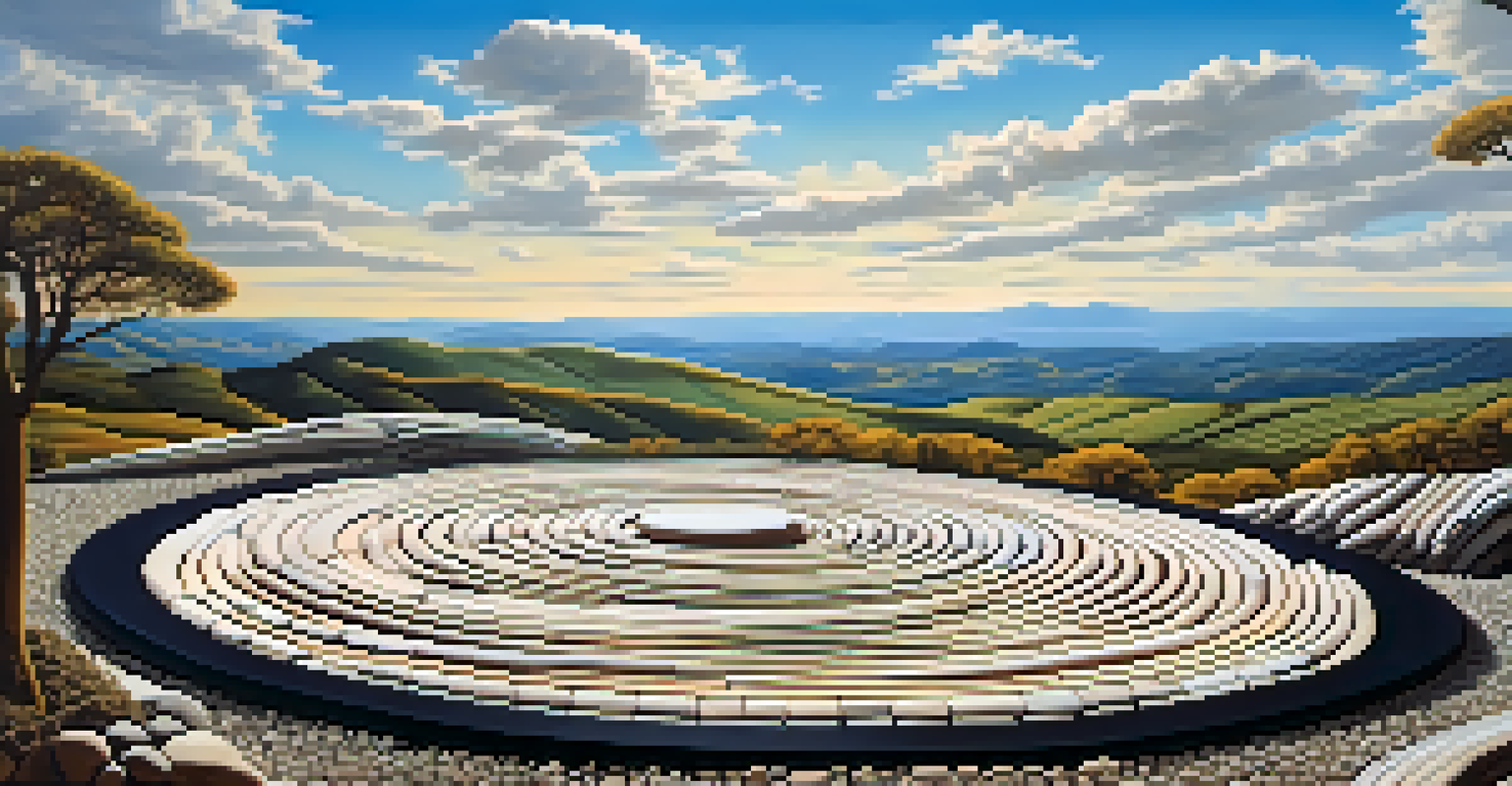Eco-Art Movements: Art as a Response to Environmental Issues

Understanding Eco-Art: A Definition and Overview
Eco-art is an artistic movement that seeks to address environmental issues through creative expression. It blends art with activism, aiming to raise awareness about ecological concerns and inspire change. Often, eco-artists use natural materials and sustainable practices to create their work, emphasizing the intimate relationship between art and nature.
Art can change the world because it can change people’s hearts.
This movement has gained momentum in response to growing environmental challenges, such as climate change and habitat destruction. Artists often explore themes of conservation, biodiversity, and the impact of human activity on the planet. By doing so, they encourage viewers to reflect on their relationship with nature and consider their role in protecting it.
Eco-art spans various forms, including installations, land art, and community projects. Each piece not only serves as a form of artistic expression but also as a catalyst for dialogue about pressing environmental issues. This unique approach allows artists to connect with audiences on both emotional and intellectual levels.
Historical Context: Roots of Eco-Art Movements
To appreciate eco-art, it's essential to understand its historical context. The movement can trace its roots back to the 1960s and 1970s when artists began responding to the environmental crises of the time. Notably, the Land Art movement emerged, with artists creating large-scale works in natural landscapes, highlighting the beauty and fragility of the environment.

As the environmental movement gained traction, artists like Robert Smithson and Andy Goldsworthy explored the interplay between art and nature. Their works often involved using organic materials, emphasizing the transient nature of art as well as the impermanence of the natural world. This laid the groundwork for subsequent eco-art movements.
Eco-Art Blends Creativity and Activism
Eco-art is an artistic movement that creatively addresses environmental issues while inspiring change and raising awareness.
In the decades that followed, eco-art expanded to include diverse voices and practices, reflecting a broader understanding of environmental activism. From indigenous artists to urban interventions, the movement has evolved, showing that art can be a powerful tool for addressing ecological issues on a global scale.
Notable Eco-Art Projects and Artists
Several artists have made significant contributions to the eco-art movement, each with their unique approach to environmental issues. For instance, Christo and Jeanne-Claude are famous for their large-scale installations, such as 'The Gates' in Central Park, which prompted discussions about public space and environmental stewardship. Their work often encourages viewers to see familiar landscapes in new ways.
We do not inherit the earth from our ancestors; we borrow it from our children.
Another notable figure is Agnes Meyer-Brandis, who combines art and science in her projects. Her work often explores themes of space exploration and our connection to the Earth, inviting audiences to consider their role in the universe. By blending different disciplines, she challenges traditional boundaries and encourages innovative thinking.
Moreover, installations like 'The Ocean Cleanup' by Boyan Slat highlight the intersection of technology and art in addressing environmental challenges. Slat's mission to remove plastic from the oceans not only serves a crucial ecological purpose but also inspires a new generation of eco-conscious artists and activists.
The Role of Community in Eco-Art Initiatives
Community involvement is a cornerstone of many eco-art projects, emphasizing the power of collective action. Through workshops, public installations, and collaborative art-making, artists engage local communities in discussions about environmental sustainability. This participatory approach fosters a sense of ownership and responsibility towards the environment.
For example, community gardens often serve as living artworks that promote biodiversity and food security. These spaces not only beautify urban areas but also educate residents about sustainable practices and the importance of green spaces. By nurturing connections within the community, eco-art projects can lead to lasting change.
Community Engagement is Essential
Eco-art projects thrive on community involvement, fostering collective action and empowering local voices in environmental discussions.
Additionally, eco-art initiatives can empower marginalized voices, giving them a platform to express their concerns about environmental justice. Through storytelling and visual representation, these projects highlight the intersection of social issues and environmental challenges, creating a holistic approach to eco-art.
Eco-Art and Climate Change Awareness
One of the most pressing issues eco-art addresses is climate change. Artists are using their platforms to visualize the impacts of global warming, sparking conversations and inspiring action. By depicting the consequences of climate change through powerful imagery, they create an emotional connection that can motivate people to take steps towards sustainability.
For instance, installations like 'Ice Watch' by Olafur Eliasson brought melting ice from Greenland to urban centers, allowing people to experience the tangible effects of climate change firsthand. This immersive approach helps bridge the gap between abstract scientific data and personal experience, making the issue more relatable.
Furthermore, eco-art can also serve as a form of protest against environmental degradation. Through visual storytelling and symbolic gestures, artists can highlight the urgency of climate action, making it clear that the time for change is now. This combination of art and advocacy strengthens the call for environmental justice.
The Future of Eco-Art Movements
As environmental issues continue to evolve, so too will eco-art movements. The future promises a blend of innovative technologies and sustainable practices that can further amplify artists' messages. With advancements in areas like augmented reality and eco-friendly materials, artists have more tools than ever to engage audiences and convey their concerns creatively.
Moreover, the rise of social media has transformed how eco-art is shared and experienced. Artists can now reach global audiences, fostering a sense of community among eco-conscious individuals. This interconnectedness can lead to collaborative projects that transcend geographical boundaries, inspiring collective action for the planet.
Art as a Tool for Climate Awareness
Artists use eco-art to visualize the impacts of climate change, creating emotional connections that motivate sustainable action.
Ultimately, the future of eco-art will depend on artists' ability to adapt and respond to the changing landscape of environmental challenges. By continuing to challenge norms and engage communities, eco-art will remain a vital force in advocating for a sustainable future.
Conclusion: Art as a Catalyst for Environmental Change
In conclusion, eco-art movements play a crucial role in addressing environmental issues and fostering awareness. Through creative expression, artists can engage audiences in meaningful dialogues about sustainability and conservation. By challenging perceptions and inspiring action, eco-art serves as a powerful catalyst for change.
As we face unprecedented environmental challenges, the importance of art in this conversation cannot be overstated. Eco-art invites us to rethink our relationship with nature and encourages us to take responsibility for our actions. It is a reminder that creativity and activism can go hand in hand in the pursuit of a healthier planet.

Ultimately, eco-art movements inspire hope and resilience, reminding us that through collective efforts, we can create a brighter future for ourselves and the generations to come. By supporting and engaging with eco-art, we contribute to a more sustainable world, one creative expression at a time.